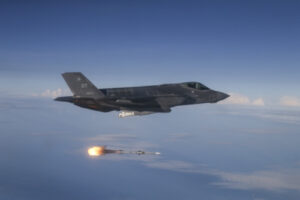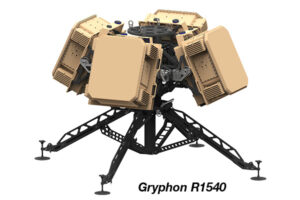Defense Daily
-
 Intelligence Community
Intelligence CommunityNGA Close To Operational Use Of New GEOINT Tasking Tool For Combatant Commands
ST. LOUIS—A new version of the National Geospatial-Intelligence Agency’s (NGA) primary tool for ordering imagery should be ready for operational use later this year, an agency official said. The tailored […]
-
 Air Force
Air ForceAllvin: F-47 Development ‘Can Come at the Speed of Software, not Hardware’
The U.S. Air Force has more control over the development of the Boeing [BA] F-47 fighter than the service has had for the Lockheed Martin [LMT] F-35 Lightning II, Air […]
Tagged in: -
 Air Force
Air ForceUSAF, Anduril, General Atomics Market CCA
While U.S. Air Force Chief of Staff Gen. Dave Allvin posted on X on May 1 that the two Collaborative Combat Aircraft (CCA) prototypes–Anduril Industries‘ YFQ-44A Fury and General Atomics‘ […]
Tagged in: -
 Homeland Security
Homeland SecurityCBP Upgrading Mobile Surveillance Systems With Radar From SRC To Improve Border Security
Benchmark Electronics [BHE] is upgrading its Mobile Video Surveillance Systems [MVSS] with a radar provided by SRC to increase range and add autonomy for border security operations. Customs and Border […]
-
 Uncategorized
UncategorizedFirst Production Unit of B61-13 Gravity Bomb Complete, Pantex Says
The first production unit of the B61-13 gravity bomb is complete, nearly a year ahead of schedule, Pantex Plant prime PanTeXas Deterrence said Monday. The first production unit was completed […]
-
 Uncategorized
UncategorizedKilby, Strategic Systems Lead Weigh ‘Alternatives’ For SLCM-N
Adm. James Kilby, acting Chief of Naval Operations, said last week that he was in talks with the director of Strategic Systems Programs on nuclear-armed, sea-launched cruise missile (SLCM-N) alternatives. […]
-
 Advanced / Transformational Technology
Advanced / Transformational TechnologySRC Details New R1430/1440 And R1540 Multi-Mission Radars
SRC Inc. on Tuesday detailed the expansion of its Gryphon family of multi-mission radars with the new R1430/R1440 and R1540 systems, noting the latter has been “extensively deployed with the […]
-
Tuesday, May 20, 2025
- IC Exploring How To Reform Procurement Process To Expand Opportunities, Gabbard Says
- Key Geospatial Intel Lesson Of Ukraine War Is Closing Kill Chain, NATO Official Says
- Bell ‘Confident’ In Meeting Army’s FLRAA Acceleration, First Prototype Delivery In 2027
- Space Force Awards LeoLabs $14 Million For Space Domain Awareness Radar In Indo-Pacific
- Unarmed Minuteman III Test launch Scheduled for Wednesday Morning
- Mack Defense Nabs Marine Corps Deal To Build Medium Tactical Truck Prototypes
- Kilby: HELIOS Laser Weapon Problems Delayed Testing, Not At Full Power
- Intelligence Community-Focused Vibrint Acquires Ampsight Adding New Customers
- Electric Boat And UAW Union Avoid Strike In Tentative Agreement
- As USAF Looks to Future Requirements for CCA Radars, Raytheon Announces First Flight of PhantomStrike
- Los Alamos Plutonium Facility Moves Into 24/7 Operations, DNFSB Reports
- NGA Plans Upcoming Commercial Analytics Awards In Several Areas
- USAF Cites ‘Design, Production, and Installation Cost Increases’ for B-52 RMP Breach
- Commercial Satellite Imagery Leaders See Increased International Demand
-
 Navy/USMC
Navy/USMCMack Defense Nabs Marine Corps Deal To Build Medium Tactical Truck Prototypes
The Marine Corps has awarded Mack Defense a deal to build two prototypes for its Medium Tactical Truck (MTT) program, which will inform a potential replacement for its Medium Tactical […]
-
Tuesday, May 20, 2025
- Commercial Satellite Imagery Leaders See Increased International Demand
- Key Geospatial Intel Lesson Of Ukraine War Is Closing Kill Chain, NATO Official Says
- Bell ‘Confident’ In Meeting Army’s FLRAA Acceleration, First Prototype Delivery In 2027
- Electric Boat And UAW Union Avoid Strike In Tentative Agreement
- USAF Cites ‘Design, Production, and Installation Cost Increases’ for B-52 RMP Breach
- Mack Defense Nabs Marine Corps Deal To Build Medium Tactical Truck Prototypes
- Intelligence Community-Focused Vibrint Acquires Ampsight Adding New Customers
- Los Alamos Plutonium Facility Moves Into 24/7 Operations, DNFSB Reports
- IC Exploring How To Reform Procurement Process To Expand Opportunities, Gabbard Says
- Kilby: HELIOS Laser Weapon Problems Delayed Testing, Not At Full Power
- As USAF Looks to Future Requirements for CCA Radars, Raytheon Announces First Flight of PhantomStrike


